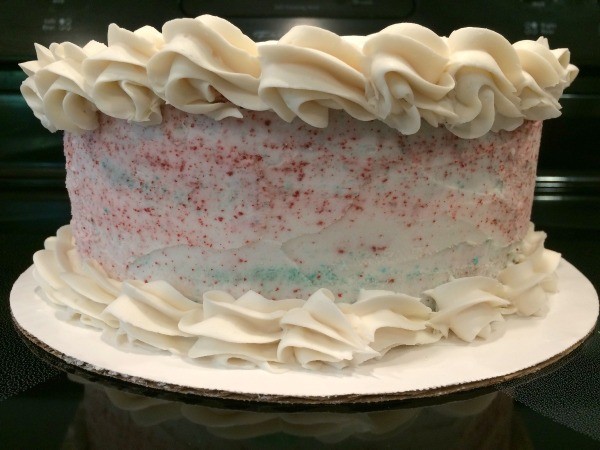
If you are using a small or medium sized nozzle, hold the nozzle at a 45º angle to the top of the cake, squeeze and release so a shell-shaped bead of buttercream comes out of the bag, moving the icing bag along, whilst continuing with this squeeze and release motion. Use an open star nozzle to create a line of shells – perfect for piping around the edges of your cake. Make sure you have plenty of buttercream in the piping bag, give it a gentle massage to ensure there are no air pockets as these could break the line mid-flow. As it remains tacky, it’s a great surface if you are wanting to completely coat a cake in buttercream and then stick sprinkles to part, or all of the surface. Using white vegetable fat alone in a ratio of 1 part fat to 2 parts icing sugar will not crust but it will give you a brilliant white colour.

It won’t crust, but is great for piping on smaller, simpler designs, such as a rose-shaped swirl on top of a cupcake.

You can use 3 parts vegan spread to 2 parts white vegetable fat to give a slightly lighter colour, but using vegan spread alone makes a really creamy buttercream. Using the same ratio of 1 part fat to 2 parts icing sugar, and 1tbsp cold water, use vegan spread in place of the butter. Add 2tbsp cold water and 2tsp vanilla extract, whisk until pale and fluffy. You need a ratio of 1 part fat to 2 parts icing sugar, so gradually whisk in 1kg of icing sugar, in batches. For a large celebration cake, with a hand-held electric hand whisk, whisk together 300g softened butter with 200g of vegetable fat until pale and fluffy. Use 3 parts butter to 2 parts white vegetable fat. The mixture of butter and vegetable fat means the buttercream will form a light crust when set, which is perfect for heavily decorated cakes as it can be touched lightly without leaving a mark. This buttercream is perfect for decorating celebration cakes. Chill the cake for 5 mins.Īpply a second coat of buttercream, applying little and often with a cutlery knife, then follow steps 4-5 above for a smooth canvas on which to decorate.

Smooth the buttercream on the top of the cake with an angled palette knife, then smooth the buttercream on the sides of the cake with a cake scraper or large palette knife.Apply a little more buttercream into any gaps or holes, if necessary. Use the tip of a cutlery knife to dot the buttercream all over the sides and top of your cake. When crumb coating, it’s best to apply the buttercream little and often, as this will help to give an even distribution and prevent dragging crumbs around the cake.Sandwich the sponges together, using generous layers of buttercream or filling of your choice, with the baked side of the top sponge facing upwards.Add a spoonful of buttercream (see 'buttercreams for piping below') to the centre of your cake board to stop your cake moving around. For a super smooth surface, ready to decorate or pipe on, start with a polished crumb coat and a fab final coat: Your sponge can be any flavour, from chocolate cake to lemon drizzle, or red velvet to coffee cake, just pick your favourite flavour and get decorating!

Vintage style cake decorating is trending at the moment, and we're all for it! Whether it's for a birthday cake, wedding cake or christening cake, wow your guests with these expert decorating techniques.


 0 kommentar(er)
0 kommentar(er)
